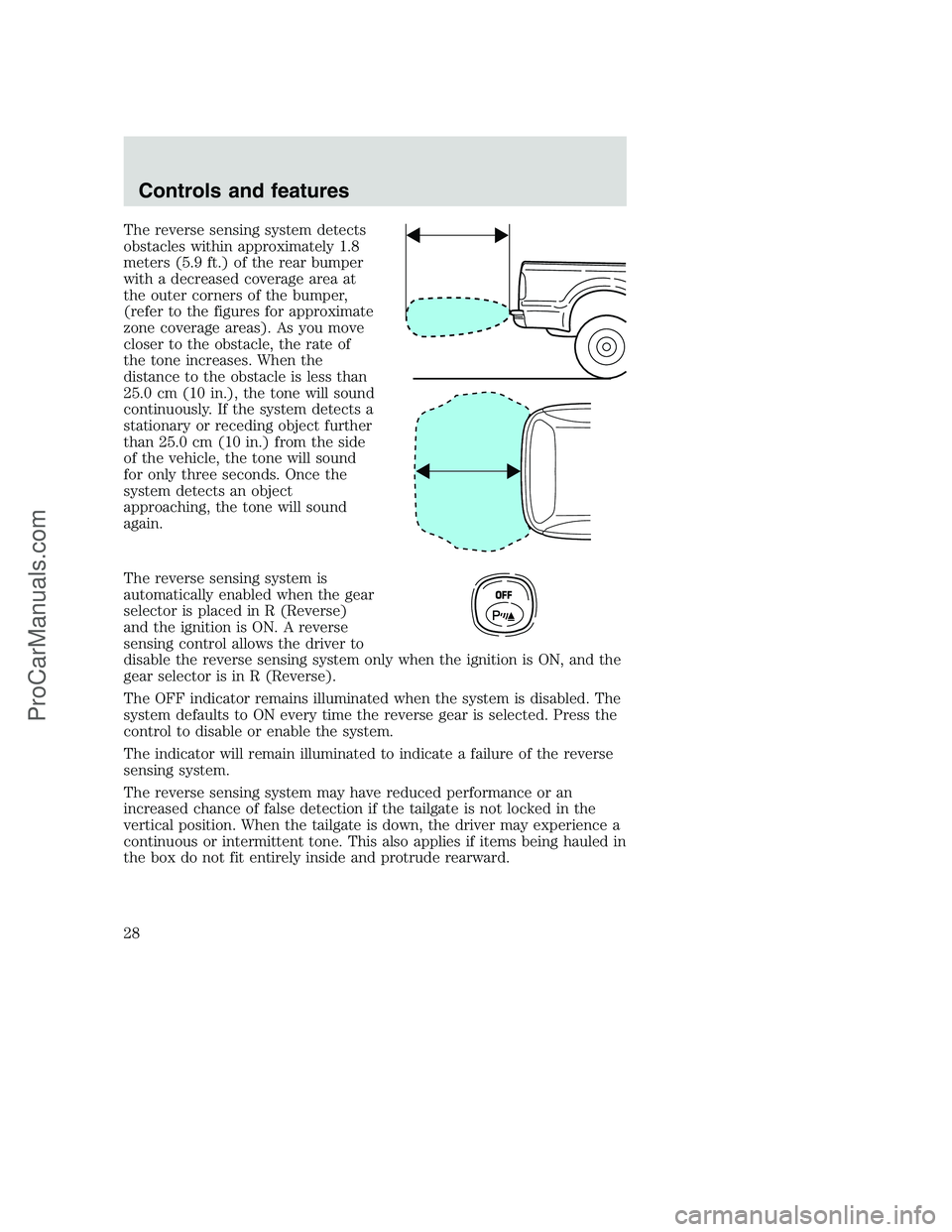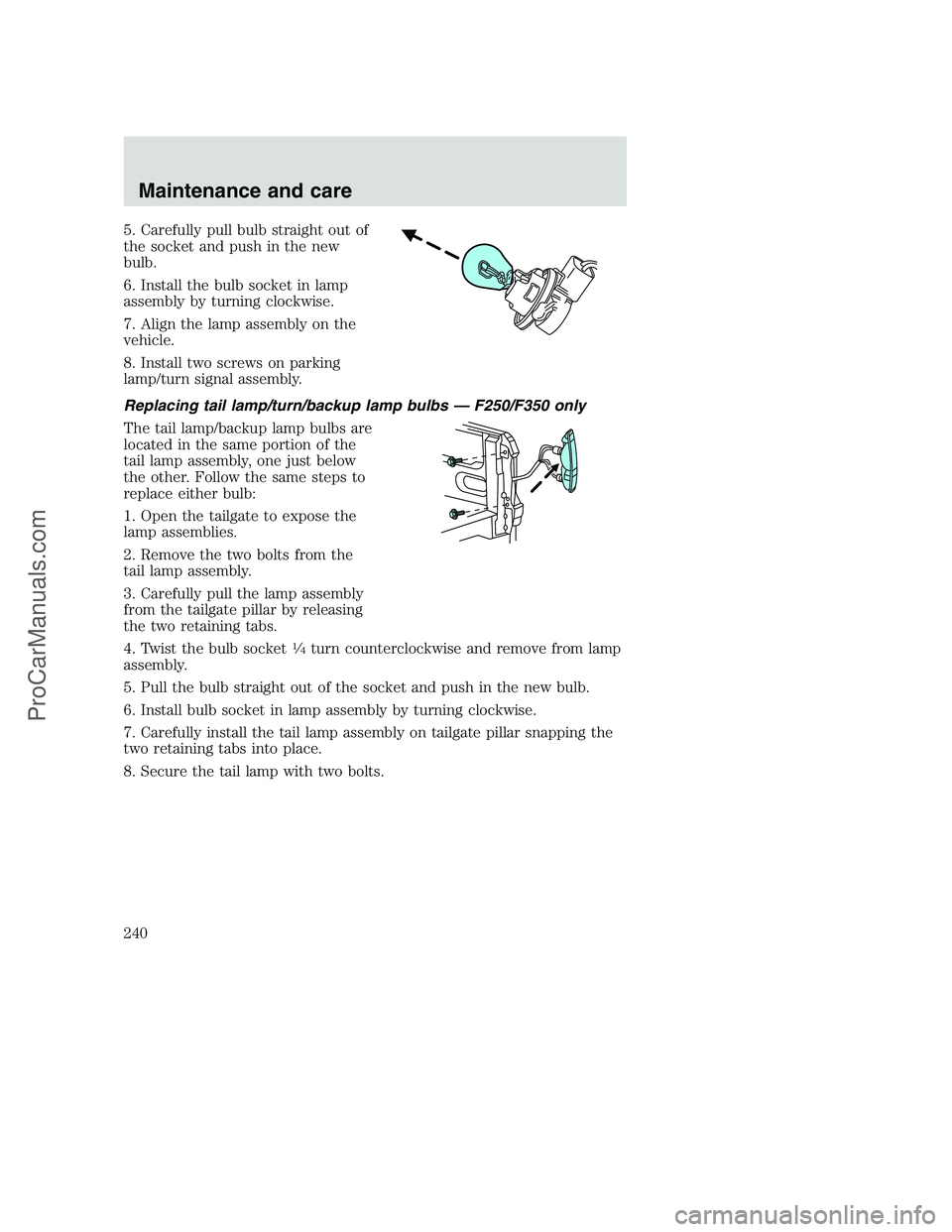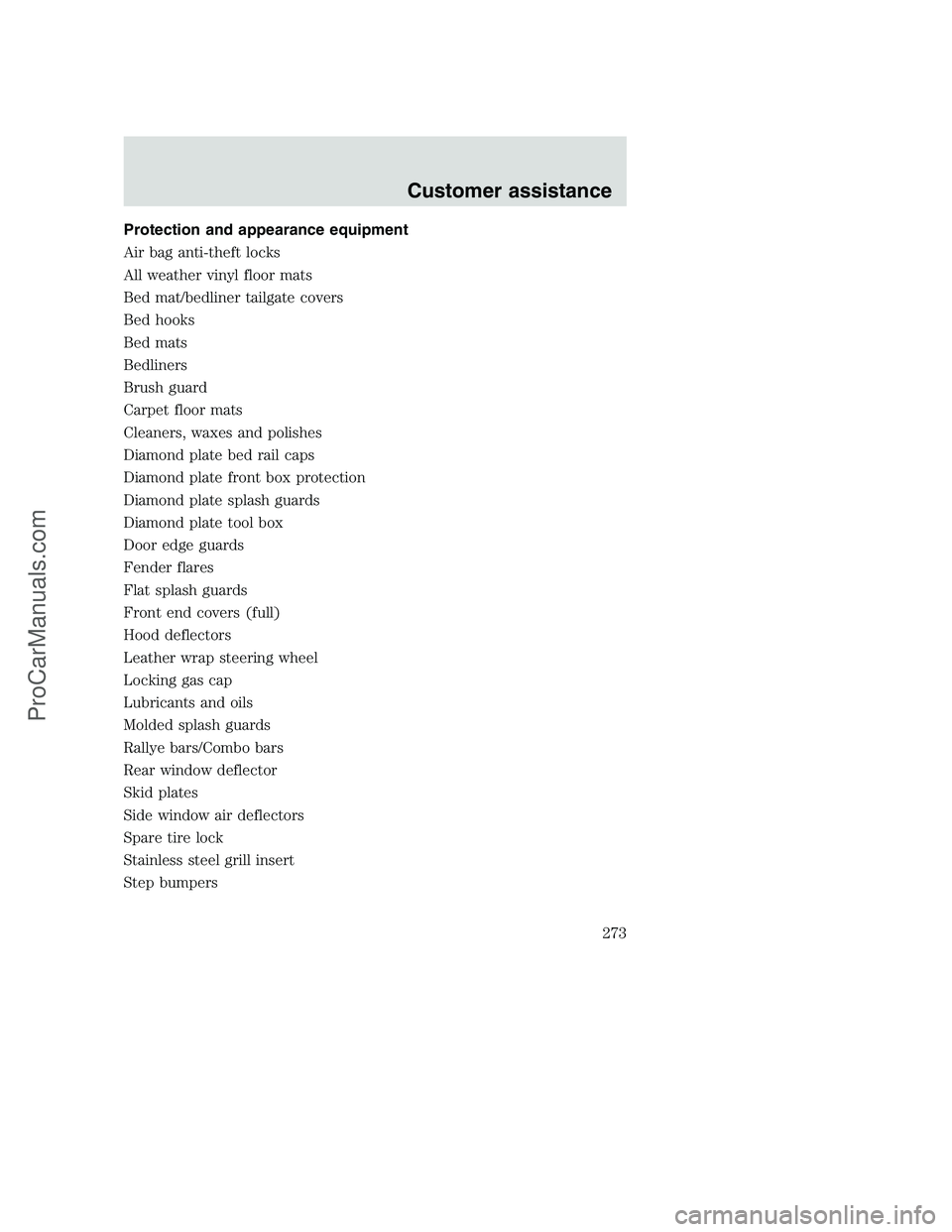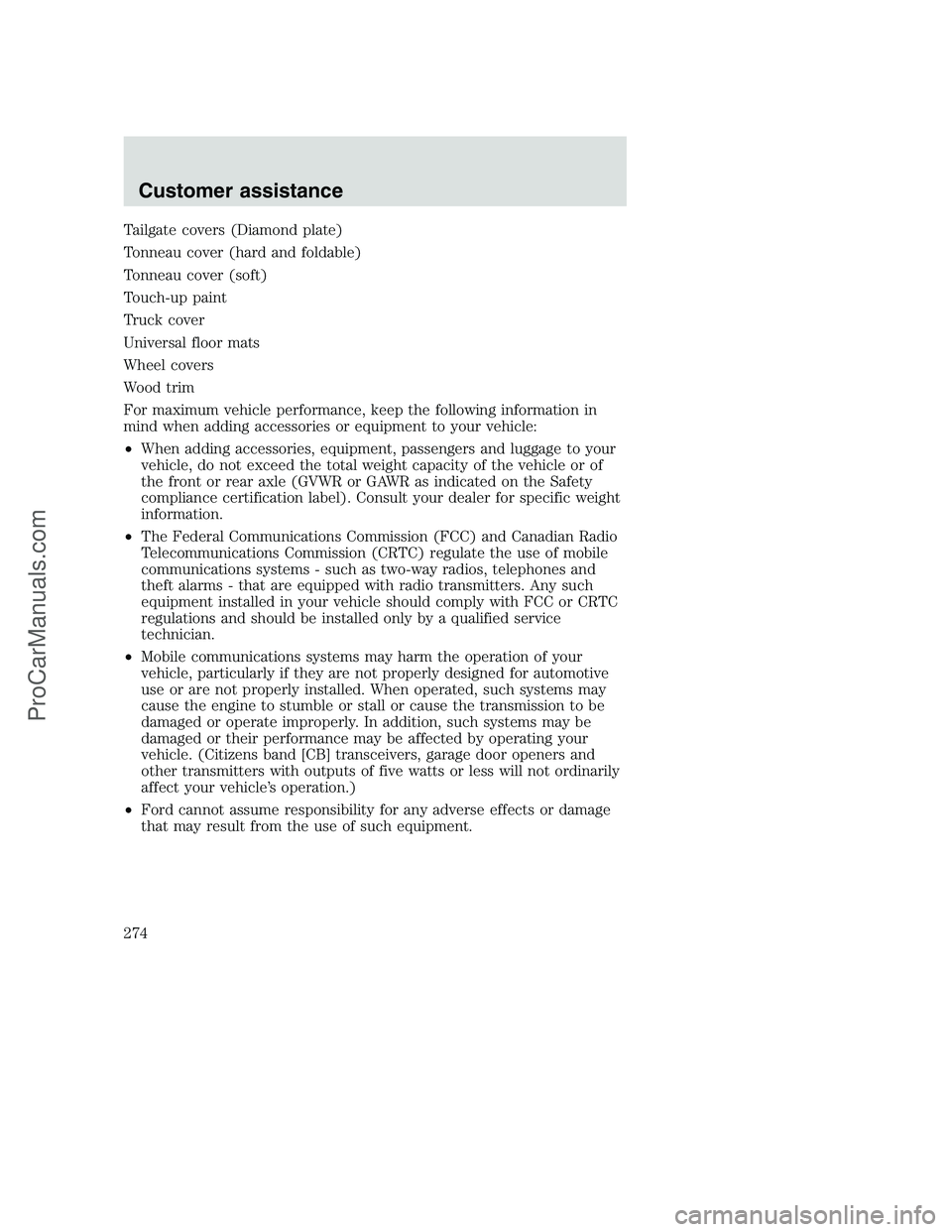2001 FORD F350 tailgate
[x] Cancel search: tailgatePage 28 of 288

The reverse sensing system detects
obstacles within approximately 1.8
meters (5.9 ft.) of the rear bumper
with a decreased coverage area at
the outer corners of the bumper,
(refer to the figures for approximate
zone coverage areas). As you move
closer to the obstacle, the rate of
the tone increases. When the
distance to the obstacle is less than
25.0 cm (10 in.), the tone will sound
continuously. If the system detects a
stationary or receding object further
than 25.0 cm (10 in.) from the side
of the vehicle, the tone will sound
for only three seconds. Once the
system detects an object
approaching, the tone will sound
again.
The reverse sensing system is
automatically enabled when the gear
selector is placed in R (Reverse)
and the ignition is ON. A reverse
sensing control allows the driver to
disable the reverse sensing system only when the ignition is ON, and the
gear selector is in R (Reverse).
The OFF indicator remains illuminated when the system is disabled. The
system defaults to ON every time the reverse gear is selected. Press the
control to disable or enable the system.
The indicator will remain illuminated to indicate a failure of the reverse
sensing system.
The reverse sensing system may have reduced performance or an
increased chance of false detection if the tailgate is not locked in the
vertical position. When the tailgate is down, the driver may experience a
continuous or intermittent tone. This also applies if items being hauled in
the box do not fit entirely inside and protrude rearward.
OFF
Controls and features
28
ProCarManuals.com
Page 88 of 288

TAILGATE LOCK (IF EQUIPPED)
Your vehicle may be equipped with a
tailgate lock designed to prevent
theft of the tailgate.
•Insert ignition key and turn to the
right to engage lock.
•Turn ignition key to the left to
unlock.
TAILGATE REMOVAL
Your tailgate is removable to allow
more room for loading.
1. Lower the tailgate.
2. Use a screwdriver to pry the
spring clip (on each connector) past
the head of the support screw.
Disconnect cable.
3. Disconnect the other cable.
4. Lift tailgate to a 45 degree angle.
5. Lift right side off of its hinge.
6. Lift left side off of its hinge.
To install, follow the removal
procedures in reverse order.
Controls and features
88
ProCarManuals.com
Page 240 of 288

5. Carefully pull bulb straight out of
the socket and push in the new
bulb.
6. Install the bulb socket in lamp
assembly by turning clockwise.
7. Align the lamp assembly on the
vehicle.
8. Install two screws on parking
lamp/turn signal assembly.
Replacing tail lamp/turn/backup lamp bulbs — F250/F350 only
The tail lamp/backup lamp bulbs are
located in the same portion of the
tail lamp assembly, one just below
the other. Follow the same steps to
replace either bulb:
1. Open the tailgate to expose the
lamp assemblies.
2. Remove the two bolts from the
tail lamp assembly.
3. Carefully pull the lamp assembly
from the tailgate pillar by releasing
the two retaining tabs.
4. Twist the bulb socket
1�4turn counterclockwise and remove from lamp
assembly.
5. Pull the bulb straight out of the socket and push in the new bulb.
6. Install bulb socket in lamp assembly by turning clockwise.
7. Carefully install the tail lamp assembly on tailgate pillar snapping the
two retaining tabs into place.
8. Secure the tail lamp with two bolts.
Maintenance and care
240
ProCarManuals.com
Page 273 of 288

Protection and appearance equipment
Air bag anti-theft locks
All weather vinyl floor mats
Bed mat/bedliner tailgate covers
Bed hooks
Bed mats
Bedliners
Brush guard
Carpet floor mats
Cleaners, waxes and polishes
Diamond plate bed rail caps
Diamond plate front box protection
Diamond plate splash guards
Diamond plate tool box
Door edge guards
Fender flares
Flat splash guards
Front end covers (full)
Hood deflectors
Leather wrap steering wheel
Locking gas cap
Lubricants and oils
Molded splash guards
Rallye bars/Combo bars
Rear window deflector
Skid plates
Side window air deflectors
Spare tire lock
Stainless steel grill insert
Step bumpers
Customer assistance
273
ProCarManuals.com
Page 274 of 288

Tailgate covers (Diamond plate)
Tonneau cover (hard and foldable)
Tonneau cover (soft)
Touch-up paint
Truck cover
Universal floor mats
Wheel covers
Wood trim
For maximum vehicle performance, keep the following information in
mind when adding accessories or equipment to your vehicle:
•When adding accessories, equipment, passengers and luggage to your
vehicle, do not exceed the total weight capacity of the vehicle or of
the front or rear axle (GVWR or GAWR as indicated on the Safety
compliance certification label). Consult your dealer for specific weight
information.
•The Federal Communications Commission (FCC) and Canadian Radio
Telecommunications Commission (CRTC) regulate the use of mobile
communications systems - such as two-way radios, telephones and
theft alarms - that are equipped with radio transmitters. Any such
equipment installed in your vehicle should comply with FCC or CRTC
regulations and should be installed only by a qualified service
technician.
•Mobile communications systems may harm the operation of your
vehicle, particularly if they are not properly designed for automotive
use or are not properly installed. When operated, such systems may
cause the engine to stumble or stall or cause the transmission to be
damaged or operate improperly. In addition, such systems may be
damaged or their performance may be affected by operating your
vehicle. (Citizens band [CB] transceivers, garage door openers and
other transmitters with outputs of five watts or less will not ordinarily
affect your vehicle’s operation.)
•Ford cannot assume responsibility for any adverse effects or damage
that may result from the use of such equipment.
Customer assistance
274
ProCarManuals.com
Page 283 of 288

belt minder .............................103
cleaning the safety
belts .................................106, 248
extension assembly ................102
for adults .............................94–97
for children .....................116–117
lap belt ....................................101
warning light and
chime .....................12, 14–15, 102
Safety seats for children ..........118
Seat belts (see Safety
restraints) ....................................93
Seats ............................................89
child safety seats ....................118
cleaning ...................................248
Servicing your vehicle ..............197
Snowplowing .................4, 163–165
Spark plugs,
specifications .....................249, 256
Special notice ............................3, 5
ambulance conversions ..............4
diesel-powered vehicles .............3
four-wheel drive vehicles .......166
utility-type vehicles ....................4
Specification chart,
lubricants ...........................253, 256
Speed control ..............................72
Speedometer ...............................17
Starting your vehicle ........126, 128
jump starting ..........................191
Steering wheel
tilting .........................................77
T
Tachometer .................................18
Tailgate ........................................88Tires ...........................179, 222–224
changing ..........................179, 181
checking the pressure ............224
replacing ..................................225
rotating ....................................224
snow tires and chains ............226
tire grades ...............................223
treadwear ................................223
Towing .......................................157
trailer towing ..........................157
wrecker ....................................196
Traction-lok rear axle ...............134
Transfer case
fluid checking .........................217
Transmission .............................136
fluid, checking and adding
(automatic) .............................214
fluid, checking and adding
(manual) .................................216
fluid, refill capacities ..............249
lubricant specifications ..253, 256
manual operation ....................139
Transmission control indicator
light ..............................................12
Trip odometer .............................18
Turn signal ............................13, 72
V
Vehicle dimensions ...................256
Vehicle Identification Number
(VIN) ..........................................262
Vehicle loading ..........................154
Ventilating your vehicle ...........130
W
Warning chimes .....................14–15
Index
283
ProCarManuals.com